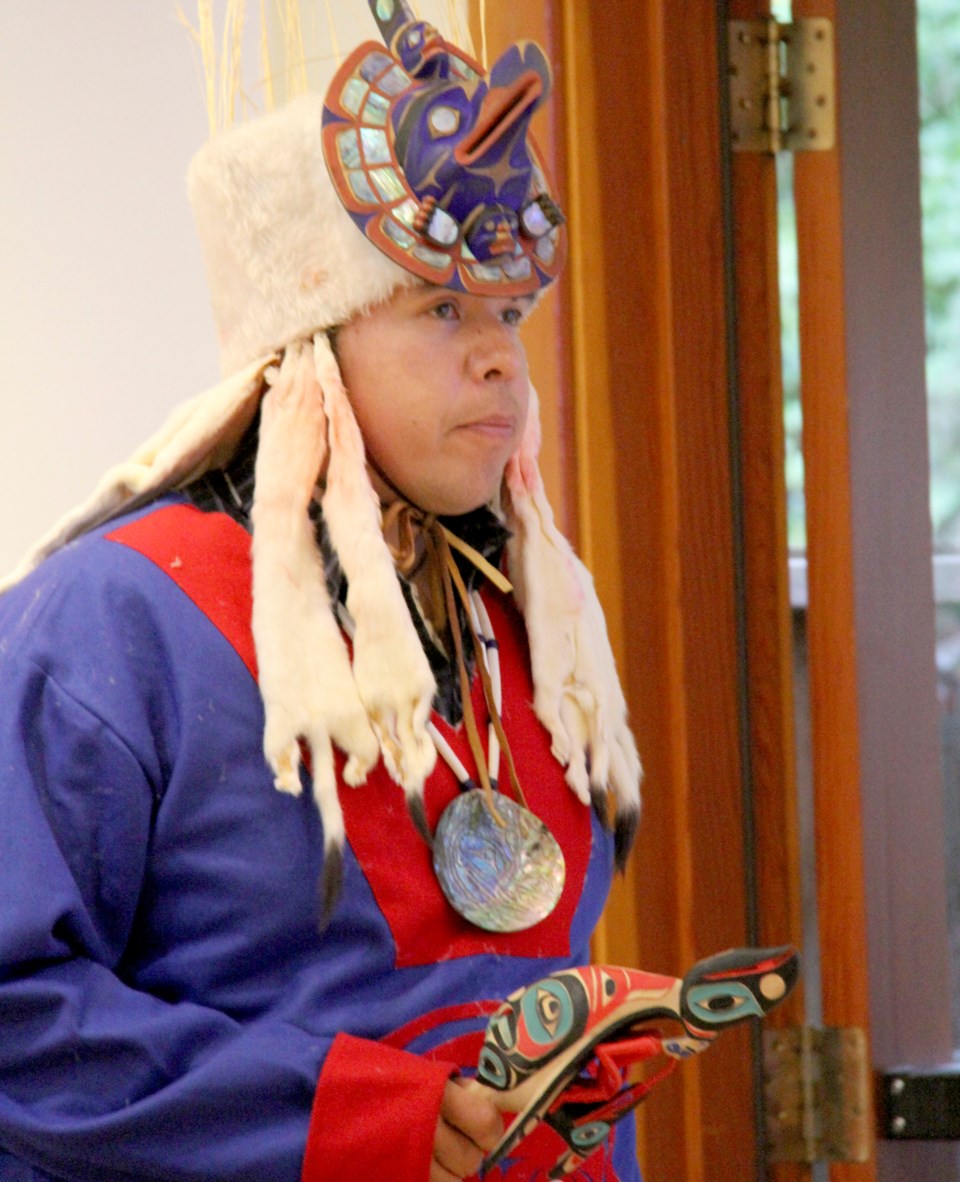The more I experience aboriginal culture, the more I appreciate how the dancing, drumming, singing, and carving are very much about transformation. And for a few hours on May 16, Simon Daniel James, guest curator, and his fellow artists and dancers transformed the Gallery at Artisan Square into a Longhouse. At the Grand Reception, over 130 of us were welcomed, offered a culinary feast of salmon, bannock, clam fritters, canoe potato, elk meatballs (more about those later) and drummed into a world beyond the boundaries of our island.
Not since 2006, the second year of the Voices in the Sound Festival, have we enjoyed such a public presence of aboriginal artistry. The gallery walls displayed the spirit, ingenuity and skill of carvers, jewelry makers, and painters. From massive pieces by Bowen Islander Gerald Morisseau, a Cree artist, and Ray Natraoro, a Coast Salish carver, to the delicate silver pendants made by Rory Dawson of the Kwakwaka’wakw Nation.
Last week, Simon and I chatted in his home studio, to the lively musical accompaniment of two-year-old Mizuki on drums, train whistle and tambourine. Before he began carving, painting, sculpting, and animating, Simon was a commercial fisherman. Normally, says Simon, he does everything himself. For this event, “I had to learn how to delegate – even the cooking.” His relatives recommended Jason Elias, a graduate of Vancouver Island University Culinary Arts program. Simon created the menu, including the above-mentioned elk meatballs. He had tried – unsuccessfully - for years to get his wife, Naomi, to enjoy elk, enhancing them with various spices. He met Naomi in Fukushima where he was carving totem poles. For the feast, he decided to sweeten the elk with a Saskatoon berry glaze. Naomi liked it. And so did the feasters.
Despite best intentions, Simon got involved with the cooking and serving up. “If I hadn’t taken over there would have been no food.” He was still cooking when Naomi told him to go home and get dressed. He was wearing his pajamas from the night before. Simon raced home, washed up, changed and came back twenty minutes later in time for the dancing. He quipped about the lateness of things: “We’re on Bowen time and Indian time.”
Simon is a powerful dancer. “Dancing has been a big part of my life. When I was seven, I danced for Queen Elizabeth at the Queen Elizabeth Theatre.” When he was 17 he started a dance troupe in Campbell River. He was pleased when his cousin, Sammy Dawson, agreed to dance with the Echo Mask Simon had carved with his grandfather. It was sold to a gallery and the owners allow him to borrow it for special events – such as Simon’s wedding. It was moving to hear Simon speak about his grandfather. “I was with my grandfather since the day I was born and was with him when he died.” When they carved together, Simon’s grandfather would ask him to do the mechanics. “That’s how my brain works,” he said. “I prefer to do transformation masks using ancient, simple ways – the fulcrum, the screw.”
The Echo Mask, a way for the elders to explain how sound reverberates off a hard surface, has interchangeable beaks – all birds - including Eagle, Kolus (like an eagle with teeth), and an articulated Raven beak which opens and closes when the dancer pulls the string. There was also some assured impromptu dancing provided by Simon’s five-year-old son, Ryuki.
Other artists in the exhibit included islander, Dawn Smoke, a Mohawk artist, who offered jewelry as well as unusual larger pieces, Debra Sparrow, a renowned Musqueam weaver, and Ian Reid, a Heiltsuk artist, who engaged in some reverse “cultural appropriation” by including images of the Dalai Lama in his paintings Descending into Mindfulness and Raven obtains en-LIGHT-enment, suggesting a similar consciousness in Indigenous and Buddhist teachings. Dzunokwa, whose name means Wild Woman of the Woods, a terrifying creature who eats young children, was represented in Lou-Ann Neel’s acrylic piece, and Simon’s powerful mask – guaranteed to keep any child out of the woods.
Many thanks to Janet Esseiva and Jacqueline Massey of the arts council for supporting this exhibit. May they build on this success and invite more aboriginal participation. How about an evening of traditional aboriginal dance and storytelling? In conversation with Rory Dawson, Simon’s cousin from Kingcome Inlet, I learned he has a dance troupe that shares songs/dances to educate people about the Kwakwaka’wakw Nation’s world view, history & culture.
If you haven’t yet seen the exhibit, I encourage you to drop by the Gallery and allow yourself to be transformed.
Pauline Le Bel is an Emmy-nominated screenwriter, award-winning novelist and the author of Becoming Intimate with the Earth.



